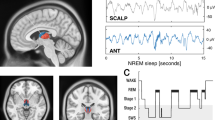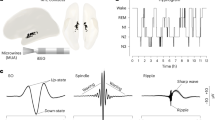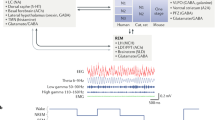Abstract
The slow (<1 Hz) rhythm, the most important electroencephalogram (EEG) signature of non–rapid eye movement (NREM) sleep, is generally viewed as originating exclusively from neocortical networks. Here we argue that the full manifestation of this fundamental sleep oscillation in a corticothalamic module requires the dynamic interaction of three cardinal oscillators: one predominantly synaptically based cortical oscillator and two intrinsic, conditional thalamic oscillators. The functional implications of this hypothesis are discussed in relation to other EEG features of NREM sleep, with respect to coordinating activities in local and distant neuronal assemblies and in the context of facilitating cellular and network plasticity during slow-wave sleep.
This is a preview of subscription content, access via your institution
Access options
Subscribe to this journal
Receive 12 print issues and online access
$209.00 per year
only $17.42 per issue
Buy this article
- Purchase on Springer Link
- Instant access to full article PDF
Prices may be subject to local taxes which are calculated during checkout






Similar content being viewed by others
References
Metherate, R., Cox, C.L. & Ashe, J.H. Cellular bases of neocortical activation: modulation of neural oscillations by the nucleus basalis and endogenous acetylcholine. J. Neurosci. 12, 4701–4711 (1992).
Steriade, M., Nuñez, A. & Amzica, F. A novel slow (<1 Hz) oscillation of neocortical neurons in vivo: depolarizing and hyperpolarizing components. J. Neurosci. 13, 3253–3265 (1993).
Steriade, M., Nuñez, A. & Amzica, F. Intracellular analysis between slow (<1 Hz) neocortical oscillation and other sleep rhythms of the electroencephalogram. J. Neurosci. 13, 3266–3283 (1993).
Steriade, M., Contreras, D., Curró Dossi, R. & Nuñez, A. The slow (<1 Hz) oscillation in reticular thalamic and thalamocortical neurons: scenario of sleep rhythm generation in interacting thalamic and neocortical networks. J. Neurosci. 13, 3284–3299 (1993).
Achermann, P. & Borbély, A. Low-frequency (<1 Hz) oscillations in the human sleep EEG. Neuroscience 81, 213–222 (1997).
Cash, S.S. et al. The human K-complex represents an isolated cortical down-state. Science 324, 1084–1087 (2009).
Greenberg, D.S., Houweling, A.R. & Kerr, J.N.D. Population imaging of ongoing neuronal activity in the visual cortex of awake rats. Nat. Neurosci. 11, 749–751 (2008).
Kerr, J.N.D., Greenberg, D. & Helmchen, F. Imaging input and output of neocortical networks in vivo. Proc. Natl. Acad. Sci. USA 102, 14063–14068 (2005).
Luczak, A., Barthó, P., Marguet, S.L., Buzsáki, G. & Harris, K.D. Sequential structure of neocortical spontaneous activity in vivo. Proc. Natl. Acad. Sci. USA 104, 347–352 (2007).
Massimini, M., Huber, R., Ferrarelli, F., Hill, S. & Tononi, G. The sleep slow oscillation as a traveling wave. J. Neurosci. 24, 6862–6870 (2004).
Petersen, C.C.H., Hahn, T.T.G., Mehta, M., Grinvald, A. & Sakmann, B. Interaction of sensory responses with spontaneous depolarization in layer 2/3 barrel cortex. Proc. Natl. Acad. Sci. USA 100, 13638–13643 (2003).
Puig, M.V., Ushimaru, M. & Kawaguchi, Y. Two distinct activity patterns of fast-spiking interneurons during neocortical UP states. Proc. Natl. Acad. Sci. USA 105, 8428–8433 (2008).
Simon, N.R., Kemp, B., Manshanden, I. & Lopes da Silva, F.H. Whole-head measures of sleep from MEG signals and the ubiquitous “slow oscillation”. Sleep Res. Online 5, 105–113 (2003).
Volgushev, M., Chauvette, S., Mukovski, M. & Timofeev, I. Precise long-range synchronization of activity and silence in neocortical neurons during slow-wave sleep. J. Neurosci. 26, 5665–5672 (2006).
Blethyn, K.L., Hughes, S.W., Tóth, T.I., Cope, D.W. & Crunelli, V. Neuronal basis of the slow (<1Hz) oscillation in neurons of the nucleus reticularis thalami in vitro. J. Neurosci. 26, 2474–2486 (2006).
Cossart, R., Aronov, D. & Yuste, R. Attractor dynamics of network UP states in the neocortex. Nature 423, 283–288 (2003).
Dang-Vu, T.T. et al. Spontaneous neural activity during human slow wave sleep. Proc. Natl. Acad. Sci. USA 105, 15160–15165 (2008).
Hughes, S.W., Cope, D.W., Blethyn, K.L. & Crunelli, V. Cellular mechanisms of the slow (<1 Hz) oscillation in thalamocortical neurons in vitro. Neuron 33, 947–958 (2002).
MacLean, J.N., Watson, B.O., Aaron, G.B. & Yuste, R. Internal dynamics determine the cortical response to thalamic stimulation. Neuron 48, 811–823 (2005).
Rigas, P. & Castro-Alamancos, M.A. Thalamocortical Up states: different effects of intrinsic and extrinsic cortical inputs on persistent activity. J. Neurosci. 27, 4261–4272 (2007).
Reig, R., Gallego, R., Nowak, L.G. & Sanchez-Vives, M.V. Impact of cortical network activity on short-term synaptic depression. Cereb. Cortex 16, 688–695 (2006).
Sanchez-Vives, M.V. & McCormick, D.A. Cellular and network mechanisms of rhythmic recurrent activity in neocortex. Nat. Neurosci. 3, 1027–1034 (2000).
Shu, Y., Hasenstaub, A. & McCormick, D.A. Turning on and off recurrent balanced cortical activity. Nature 423, 288–293 (2003).
Vyazovskiy, V.V., Cirelli, C., Pfister-Genskow, M., Faraguna, U. & Tononi, G. Molecular and electrophysiological evidence for net synaptic potentiation in wake and depression in sleep. Nat. Neurosci. 11, 200–208 (2008).
Wolansky, T., Clement, E.A., Peters, S.R., Palczak, M.A. & Dickson, C.T. Hippocampal slow oscillation: a novel EEG state and its coordination with ongoing neocortical activity. J. Neurosci. 26, 6213–6229 (2006).
De Gennaro, L. et al. Cortical plasticity induced by transcranial magnetic stimulation during wakefulness affects electroencephalogram activity during sleep. PLoS One 3, e2483 (2008).
Huber, R., Ghilardi, M.F., Massimini, M. & Tononi, G. Local sleep and learning. Nature 430, 78–81 (2004).
Huber, R. et al. Arm immobilization causes cortical plastic changes and locally decreases sleep slow wave activity. Nat. Neurosci. 9, 1169–1176 (2006).
Ji, D. & Wilson, M.A. Coordinated memory replay in the visual cortex and hippocampus during sleep. Nat. Neurosci. 10, 100–107 (2007).
Marshall, L., Helgadóttir, H., Mölle, M. & Born, J. Boosting slow oscillations during sleep potentiates memory. Nature 444, 610–613 (2006).
Massimini, M., Rosanova, M. & Mariotti, M. EEG slow (approximately 1 Hz) waves are associated with nonstationarity of thalamo-cortical sensory processing in the sleeping human. J. Neurophysiol. 89, 1205–1213 (2003).
Mölle, M., Marshall, L., Gais, S. & Born, J. Learning increases human electro-encephalographic coherence during subsequent slow sleep oscillations. Proc. Natl. Acad. Sci. USA 101, 13963–13968 (2004).
Peigneux, P. et al. Are spatial memories strengthened in the human hippocampus during slow wave sleep? Neuron 44, 535–545 (2004).
Contreras, D. & Steriade, M. Cellular basis of EEG slow rhythms: a study of dynamic corticothalamic relationships. J. Neurosci. 15, 604–622 (1995).
Doi, A. et al. Slow oscillation of membrane currents mediated by glutamatergic inputs of rat somatosensory cortical neurons: in vivo patch-clamp analysis. Eur. J. Neurosci. 26, 2565–2575 (2007).
Hughes, S.W., Cope, D.W., Tóth, T.I., Williams, S.R. & Crunelli, V. All thalamocortical neurones possess a T-type Ca2+ 'window' current that enables the expression of bistability-mediated activities. J. Physiol. (Lond.) 517, 805–815 (1999).
Zhu, L. et al. Nucleus- and species-specific properties of the slow (<1 Hz) sleep oscillation in thalamocortical neurons. Neuroscience 141, 621–636 (2006).
Amzica, F. & Steriade, M. The functional significance of K-complexes. Sleep Med. Rev. 6, 139–149 (2002).
De Gennaro, L. & Ferrara, M. Sleep spindles: an overview. Sleep Med. Rev. 7, 423–440 (2003).
Hoffman, K.L. et al. The upshot of Up states in the neocortex: from slow oscillations to memory formation. J. Neurosci. 27, 11838–11841 (2007).
Mehta, M.R. Cortico-hippocampal interation during up-down states and memory consolidation. Nat. Neurosci. 10, 13–15 (2007).
Tononi, G., Massimini, M. & Riedner, B.A. Sleepy dialogues between cortex and hippocampus: who talks to whom? Neuron 52, 748–749 (2006).
Yuste, R., MacLean, J.N., Smith, J. & Lansner, A. The cortex as a central pattern generator. Nat. Rev. Neurosci. 6, 477–483 (2005).
Simon, N.R., Manshanden, I. & Lopes da Silva, F.H.A. MEG study of sleep. Brain Res. 860, 64–76 (2000).
Amzica, F. & Steriade, M. The K-complex: its slow rhythmicity and relation to delta waves. Neurology 49, 952–959 (1997).
Mölle, M., Marshall, L., Gais, S. & Born, J. Grouping of spindle activity during slow oscillations in human non-rapid eye movement sleep. J. Neurosci. 22, 10941–10947 (2002).
Amzica, F. & Steriade, M. Cellular substrates and laminar profile of sleep K-complex. Neuroscience 82, 671–686 (1998).
Destexhe, A., Contreras, D. & Steriade, M. Spatiotemporal analysis of local field potentials and unit discharges in cat cerebral cortex during natural wake and sleep states. J. Neurosci. 19, 4595–4608 (1999).
Steriade, M., Timofeev, I. & Grenier, F. Natural waking and sleep states: a view from inside neocortical neurons. J. Neurophysiol. 85, 1969–1985 (2001).
Krueger, J.M. et al. Sleep as a fundamental property of neuronal assemblies. Nat. Rev. Neurosci. 9, 910–919 (2008).
Siegel, J.M. Do all animals sleep? Trends Neurosci. 31, 208–213 (2008).
Bokor, H. et al. Selective GABAergic control of higher-order thalamic relays. Neuron 45, 929–940 (2005).
Contreras, D. & Steriade, M. Spindle oscillation in cats: the role of corticothalamic feedback in a thalamically generated rhythm. J. Physiol. (Lond.) 490, 159–179 (1996).
Contreras, D. & Steriade, M. Synchronization of low-frequency rhythms in corticothalamic networks. Neuroscience 76, 11–24 (1997).
Contreras, D. & Steriade, M. State-dependent fluctuations of low-frequency rhythms in corticothalamic networks. Neuroscience 76, 25–38 (1997).
Haider, B., Duque, A., Hasenstaub, A.R. & McCormick, D.A. Neocortical network activity in vivo is generated through a dynamic balance of excitation and inhibition. J. Neurosci. 26, 4535–4545 (2006).
Rudolph, M., Pospischil, M., Timofeev, I. & Destexhe, A. Inhibition determines membrane potential dynamics and controls action potential generation in awake and sleeping cat cortex. J. Neurosci. 27, 5280–5290 (2007).
Steriade, M. Synchronized activities of coupled oscillators in the cerebral cortex and thalamus at different levels of vigilance. Cereb. Cortex 7, 583–604 (1997).
Steriade, M. Cellular substrates of brain rhythms. in Electroencephalography: Basic Principles, Clinical Applications, and Related Fields (eds, E. Niedermeyer & F. Lopes da Silva) 27–62 (Williams and Wilkins, Baltimore, 1993).
Timofeev, I. & Steriade, M. Low-frequency rhythms in the thalamus of intact-cortex and decorticated cats. J. Neurophysiol. 76, 4152–4168 (1996).
Timofeev, I., Grenier, F., Bazhenov, M., Sejnowski, T.J. & Steriade, M. Origin of slow cortical oscillations in deafferented cortical slabs. Cereb. Cortex 10, 1185–1199 (2000).
Amzica, F. & Steriade, M. Disconnection of synaptic linkages disrupts synchronization of a slow oscillation. J. Neurosci. 15, 4658–4677 (1995).
Bazhenov, M., Timofeev, I., Steriade, M. & Sejnowski, T.J. Model of thalamocortical slow-wave sleep oscillations and transitions to activated states. J. Neurosci. 22, 8691–8704 (2002).
Compte, A., Sanchez-Vives, M.V., McCormick, D.A. & Wang, X.-J. Cellular and network mechanisms of slow oscillatory activity (<1 Hz) and wave propagations in a cortical network model. J. Neurophysiol. 89, 2707–2725 (2003).
Hill, S. & Tononi, G. Modeling sleep and wakefulness in the thalamocortical system. J. Neurophysiol. 93, 1671–1698 (2005).
Le Bon-Jego, M. & Yuste, R. Persistently active, pacemaker-like neurons in neocortex. Front. Neurosci. 1, 123–129 (2007).
Cunningham, M.O. et al. Neuronal metabolism governs cortical network response state. Proc. Natl. Acad. Sci. USA 103, 5597–5601 (2006).
Steriade, M., Timofeev, I., Grenier, F. & Dürmüller, N. Role of thalamic and cortical neurons in augmenting responses and self-sustained activity: dual intracellular recordings in vivo. J. Neurosci. 18, 6425–6443 (1998).
Swadlow, H.A. & Gusev, A.G. The impact of 'bursting' thalamic impulses at a neocortical synapse. Nat. Neurosci. 4, 402–408 (2001).
Williams, S.R., Turner, J.P., Tóth, T.I., Hughes, S.W. & Crunelli, V. The 'window' component of the low threshold Ca2+ current produces input signal amplification and bistability in cat and rat thalamocortical neurones. J. Physiol. (Lond.) 505, 689–705 (1997).
Sherman, S.M. & Guillery, R.W. Functional organization of thalamocortical relays. J. Neurophysiol. 76, 1367–1395 (1996).
Llinás, R.R. & Steriade, M. Bursting of thalamic neurons and states of vigilance. J. Neurophysiol. 95, 3297–3308 (2006).
Godwin, D.W., Van Horn, S.C., Sesma, M., Romano, C. & Sherman, S.M. Ultrastructural localization suggests that retinal and cortical inputs access different metabotropic glutamate receptors in the lateral geniculate nucleus. J. Neurosci. 16, 8181–8192 (1996).
Turner, J.P. & Salt, T.E. Characterization of sensory and corticothalamic excitatory inputs to rat thalamocortical neurones in vitro. J. Physiol. (Lond.) 510, 829–843 (1998).
Steriade, M. Grouping of brain rhythms in corticothalamic systems. Neuroscience 137, 1087–1106 (2006).
Hughes, S.W. et al. Synchronized oscillations at alpha and theta frequencies in the lateral geniculate nucleus. Neuron 42, 253–268 (2004).
Cox, C.L., Reichova, I. & Sherman, S.M. Functional synaptic contacts by intranuclear axon collaterals of thalamic relay neurons. J. Neurosci. 23, 7642–7646 (2003).
Cox, C.L. & Sherman, S.M. Control of dendritic outputs of inhibitory interneurons in the lateral geniculate nucleus. Neuron. 27, 597–610 (2000).
Soltesz, I. & Crunelli, V. A role for low-frequency, rhythmic synaptic potentials in the synchronization of cat thalamocortical cells. J. Physiol. (Lond.) 457, 257–276 (1992).
Lõrincz, M.L., Kékesi, K.A., Juhász, G., Crunelli, V. & Hughes, S.W. Temporal framing of thalamic relay-mode firing by phasic inhibition during the alpha rhythm. Neuron 63, 683–696 (2009).
Hughes, S.W., Blethyn, K.L., Cope, D.W. & Crunelli, V. Properties and origin of spikelets in thalamocortical neurones in vitro. Neuroscience 110, 395–401 (2002).
Tóth, T.I., Hughes, S.W. & Crunelli, V. Analysis and biophysical interpretation of bistable behaviour in thalamocortical neurons. Neuroscience 87, 519–523 (1998).
Crunelli, V., Tóth, T.I., Cope, D.W., Blethyn, K. & Hughes, S.W. The 'window' T-type calcium current in brain dynamics of different behavioral states. J. Physiol. (Lond.) 562, 121–129 (2005).
Crunelli, V., Cope, D.W. & Hughes, S.W. Thalamic T-type Ca2+ channels and NREM sleep. Cell Calcium 40, 175–190 (2006).
McCormick, D.A. & von Krosigk, M. Corticothalamic activation modulates thalamic firing through glutamate 'metabotropic' receptors. Proc. Natl. Acad. Sci. USA 89, 2774–2778 (1992).
Turner, J.P. & Salt, T.E. Synaptic activation of the group I metabotropic glutamate receptor mGlu1 on the thalamocortical neurons of the rat dorsal lateral geniculate nucleus in vitro. Neuroscience 100, 493–505 (2000).
Beierlein, M., Fall, C.P., Rinzel, J. & Yuste, R. Thalamocortical bursts trigger recurrent activity in neocortical networks: layer 4 as a frequency-dependent gate. J. Neurosci. 22, 9885–9894 (2002).
McCormick, D.A. Neurotransmitter actions in the thalamus and cerebral cortex and their role in neuromodulation of thalamocortical activity. Prog. Neurobiol. 39, 337–388 (1992).
Destexhe, A., Hughes, S.W., Rudolph, M. & Crunelli, V. Are corticothalamic 'up' states fragments of wakefulness? Trends Neurosci. 30, 334–342 (2007).
Isomura, Y. et al. Integration and segregation of activity in entorhinal-hippocampal subregions by neocortical slow oscillations. Neuron 52, 871–882 (2006).
Lee, A.K. & Wilson, M.A. Memory of sequential experience in the hippocampus during slow wave sleep. Neuron 36, 1183–1194 (2002).
Nádasdy, Z., Hirase, H., Czurkó, A., Csicsvari, J. & Buzsáki, G. Replay and time compression of recurring spike sequences in the hippocampus. J. Neurosci. 19, 9497–9507 (1999).
Sirota, A., Csicsvari, J., Buhl, D. & Buzsáki, G. Communication between neocortex and hippocampus during sleep in rodents. Proc. Natl. Acad. Sci. USA 100, 2065–2069 (2003).
Jones, E.G. The Thalamus (Plenum Press, New York, 2008).
Cueni, L. et al. T-type Ca2+ channels, SK2 channels and SERCAs gate sleep-related oscillations in thalamic dendrites. Nat. Neurosci. 11, 683–692 (2008).
Czarnecki, A., Birtoli, B. & Ulrich, D. Cellular mechanisms of burst firing–mediated long-term depression in rat neocortical pyramidal cells. J. Physiol. (Lond.) 578, 471–479 (2007).
Stern, E.A., Kincaid, A.E. & Wilson, C.J. Spontaneous subthreshold membrane potential fluctuations and action potential variability of rat corticostriatal and striatal neurons in vivo. J. Neurophysiol. 77, 1697–1715 (1997).
Mena-Segovia, J., Sims, H.M., Magill, P.J. & Bolam, J.P. Cholinergic brainstem neurons modulate cortical gamma activity during slow oscillations. J. Physiol. (Lond.) 586, 2947–2960 (2008).
Jones, B.E. From waking to sleeping: neuronal and chemical substrates. Trends Pharmacol. Sci. 26, 578–586 (2005).
Steriade, M., Contreras, D., Amzica, F. & Timofeev, I. Synchronization of fast (30–40 Hz) spontaneous oscillations in intrathalamic and thalamocortical networks. J. Neurosci. 16, 2788–2808 (1996).
Acknowledgements
Our work in this area is supported by the Wellcome Trust (grants 71436, 78311 and 78403).
Author information
Authors and Affiliations
Corresponding author
Supplementary information
Supplementary Text and Figures
Supplementary Note (PDF 175 kb)
Rights and permissions
About this article
Cite this article
Crunelli, V., Hughes, S. The slow (<1 Hz) rhythm of non-REM sleep: a dialogue between three cardinal oscillators. Nat Neurosci 13, 9–17 (2010). https://doi.org/10.1038/nn.2445
Published:
Issue Date:
DOI: https://doi.org/10.1038/nn.2445
This article is cited by
-
Sleep is Essential for Mental Health: Potential Role of Slow Oscillations
Current Sleep Medicine Reports (2024)
-
Diversity of cortical activity changes beyond depression during Spreading Depolarizations
Nature Communications (2023)
-
Alterations in TRN-anterodorsal thalamocortical circuits affect sleep architecture and homeostatic processes in oxidative stress vulnerable Gclm−/− mice
Molecular Psychiatry (2022)
-
The human thalamus orchestrates neocortical oscillations during NREM sleep
Nature Communications (2022)
-
Dataset of cortical activity recorded with high spatial resolution from anesthetized rats
Scientific Data (2021)



